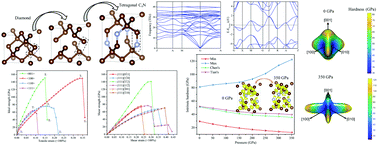Pressure-induced structure, elasticity, intrinsic hardness and ideal strength of tetragonal C4N†
Abstract
A tetragonal C4N (t-C4N) structure was predicted via CALYPSO code, and the effects of pressure on its structural and mechanical properties were studied. The results show that t-C4N is different from various 2D CxNy compounds with a new type 3D crystal structure, which is similar to diamond. Bulk t-C4N is equipped with excellent elastic properties. When the pressure is increased from 0 GPa to 350 GPa, its bulk modulus B, shear modulus G and Young's modulus E are increased from 426.9 GPa to 1123.1 GPa, 371.4 GPa to 582.9 GPa and 863.7 GPa to 1490.9 GPa, respectively. The anisotropic Bmax, Gmax and Emax are increased from 582.38 GPa to 1751.41 GPa, 478.29 GPa to 1033.97 GPa and 1281.26 GPa to 2490.14 GPa, respectively. When the pressure is 0 GPa, the hardness calculated by Chen's and Tian's models are 51.15 GPa and 51.81 GPa, respectively. Its ideal tensile strength in [111] orientation is the smallest (63.46 GPa), which indicates that the (111) planes allow easy cleavage. The smallest ideal shear strength (67.98 GPa) can be obtained in the (111)[1![[1 with combining macron]](https://www.rsc.org/images/entities/char_0031_0304.gif) 0] orientation, which suggests its theoretical hardness is about 67.98 GPa. Due to its excellent mechanical properties, t-C4N can be used as an industrial superhard material.
0] orientation, which suggests its theoretical hardness is about 67.98 GPa. Due to its excellent mechanical properties, t-C4N can be used as an industrial superhard material.



 Please wait while we load your content...
Please wait while we load your content...